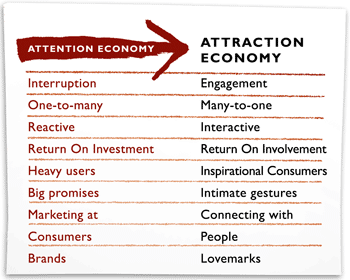T-Mobile’s Flash Mob at Trafalgar Square
In the world of advertising, it is common for one to think about generating Attention first before anything else.
After all, that age-old mnemonic AIDA (Attention, Interest, Desire, Action) is predicated on the ability to capture your target audience’s eyeballs/ eardrums in the cacophony of marketing clutter.
Well things have changed, according to Kevin Roberts, CEO of Saatchi & Saatchi Worldwide. He felt that we have not only moved out of an Attention Economy, but have progressed into both an Attraction Economy and a Participation Economy.
This evolution from push to pull to share is summarised in the table below:

Courtesy of KR Connect
First, what is an Attraction Economy?
According to the chart below, the Attraction Economy is one which involves permission, interaction, intimate gestures and emotional connection. It is kind of like building a fan-base of many followers of your brand whom you can touch on a personal and perhaps even spiritual level. (You can read more about it’s 10 principles here)
While the Attraction Economy is about greater levels of emotional engagement and interaction with one’s customers, the Participation Economy brings it further. Inspired by recent trends like flash mobbing and the prevalence of peer-to-peer sharing (often to the chagrin of copyright owners), the Participation Economy is about community, co-creation, collective action, and many-to-many communication.

Social technologies allow more participation between you and your customers (source)
Perhaps a good way to illustrate these differences is this.
In an attention economy, a marketer needs to interrupt, distract, and sell to a consumer. This is classical marketing 101 with the 4 Ps (Product, Price, Place, Promotion).
In an attraction economy, a marketer needs to cultivate relationships, understand his customer’s wishes and desires, and interact with them on an emotional level. His role is perhaps more like a relationship manager and an experience architect.
In a participation economy, however, a marketer is now a catalyst for action and a community manager. While connecting with one’s customer is important, its probably more important to rally them together and make them feel like members as opposed to buyers.
How does this change the way we work as marketers?
For a start, one needs to change the way one views customers from target audiences to brand activists. Market with your customers rather than market to them.
One should also involve one’s customers as early as possible in the nuts-and-bolts of product development. Get them interested from an early stage and seek their feedback early.
One could also study the dynamics of groups and develop the best way to cultivate a following. Find out what your customers truly care about and pledge to work closely with them on a favourite cause.
Finally, consider how you could maintain a constant dialogue with your customers in the most efficient and effective manner. Keep the relationship alive through interaction, and always keep communication channels open.
PS – For more ideas, check out this free resource by Nina Simon called the Participatory Museum, as well as Hugh Macleod’s wonderful thoughts on social objects and how marketers could use them.

